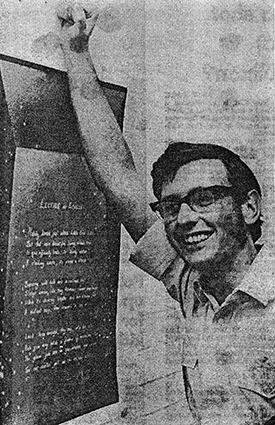This media release coincided with an exhibition at the Sculpture Centre, published as a Canberra News feature in the Canberra Times, written by Grant Thompson
November 1970
When you are ready to return to the Library or another space in the gallery, please press the appropriate button below.
Artist with 'instant magic'
EVEN THE PALETTE GLOWS
Back in the late '50s, when he was a student at Sydney University, Arthur Wicks had a visit from an easily-scandalised family friend who later reported to his mother that he was painting "naked men in lurid landscapes". The only thing naked about this work today is colour.
When his eighth one-man exhibition opened on Friday night at Narrabundah in the Australian Sculpture Gallery, there will be enough colour hung on the walls to set the place alight.
"Largely", he says, "the works in the exhibition represent the illusion of light through colour.
"Colour is the pigment, and any light that is created is the illusion".
Wicks (pictured right) is an artist who does not like to compromise himself, so he works in the public service and lectures in printmaking at Canberra Technical College.
That way, he reckons, he is not committed to producing "saleable' art.
IRONY
"And I like to eat", he
adds succinctly.
His home in Bonython Street oh, the irony of
that name - Downer, is
as unlike an artist's as you could possibly imagine.
It has, for example, a well-trimmed lawn, shrubs, a driveway, comfortable urnishings, and a wife named Joan who claims she has the real answer to her husband's twin lives as artist and worker.
"He likes to crusade in two fields at once", she says.
Out the back, squatting on the end of the
driveway, is Wicks'
studio-garage.
Its role as a studio long ago transcended its former purpose, but for some reason it is still casually- referred to as “the garage". You go through the 'wide door and caper like
Tiny Tim through the tulips to reach the rare patches of bare floor between dozens and dozens of paintings.
"Look at these paintings over here", says Wicks.
"See, they are wedge-shaped.
"This is something I've been working with for a while.”
while.
Framed and stacked around the garage, his colours swoop, fade, and wander into each other within simple geometric designs on large expanses of canvas.
Two, of his works destined for the exhibition, silk-screen prints, form "environments" for poems by Canberra poet R. F. Brissenden.
Wicks maintains his work is not avant-garde. He says he is not an
artistic megalomaniac,
trying to take the world of art by storm.
EXHAUSTING
"I think there is a danger in art — that it can be a therapy, an escape", he adds.
"It probably is therapeutic, for me, but not primarily so. It is more exhausting
than satisfying".
"It is a simple form
which allows me to concentrate on colour".
Every painting in sight is in acrylics and even, one suspects, those out of sight.
There is a big work wrapped in tar-paper and tied with twine stacked against the wall.
"That was in the Blake", Wicks explains.
 'IN A FLASH'
'IN A FLASH'
"Yes", he admits, "it is in acrylics. I like acrylic colour. It's like instant magic. You just load a brush, a spray-gun, or a
roller with the stuff, then put it on — the thing happens in a flash on the canvas".
"With oils, there is a
lot more preparation and the possibility that you might lose sight of your original idea".
You turn to leave the studio and are confronted by a garage door which would bring a fortune - it's a masterpiece.
Since Wicks began using the garage as a studio he has used the door as a testing-ground for colours and techniques with the
result that it could now best be described as a wall of a psychedelic limestone cave.
Some artists have framed their palettes and sold them to art fanciers — what is he going to do about his door?
"I'll probably paint it white", he says.
News feature by Grant Thompson
Canberra News November 1970